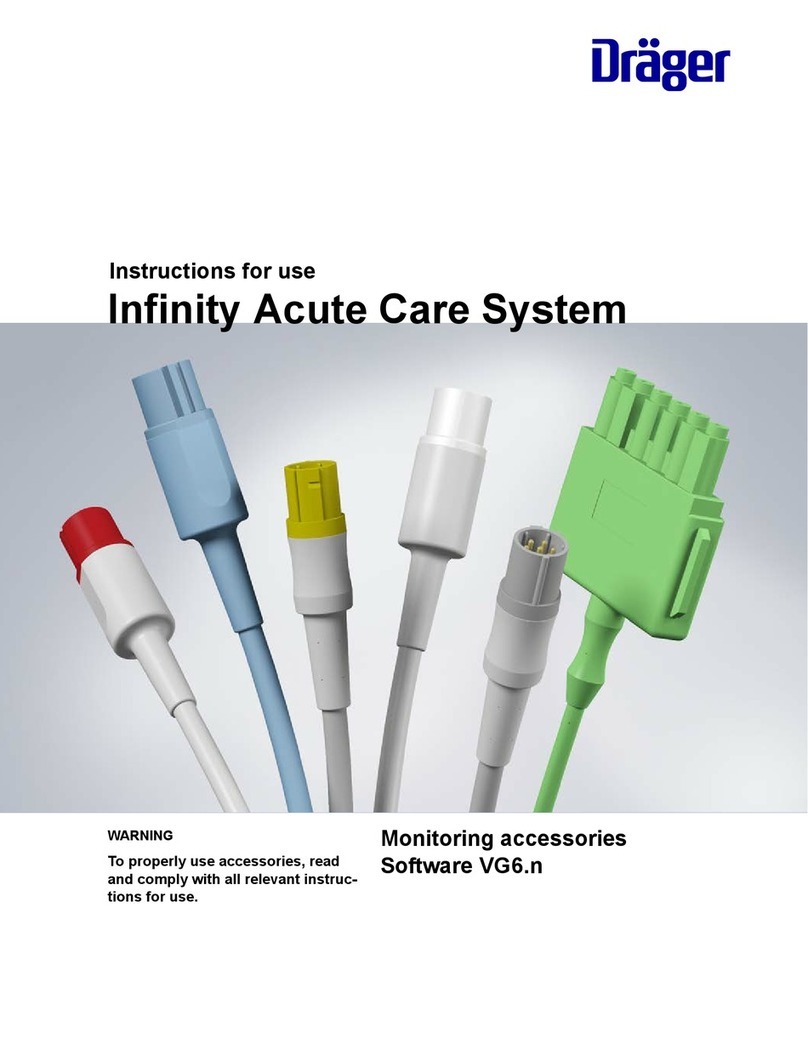
6
For Your Safety and that of Your Patients
For Your Safety and that of Your
Patients
Strictly follow the Instructions for Use
Any use of the apparatus requires full understanding and strict
observation of these instructions.
The apparatus is only to be used for purposes specified here.
Maintenance
The apparatus ust be inspected and serviced by trained
service personnel every two years.
Repair and general overhaul of the apparatus ay only be
carried out by trained service personnel.
We reco end that a service contract be obtained with
DrägerService and that all repairs also be carried out by the .
Only authentic Dräger spare parts ay be used for
aintenance.
Observe chapter "Maintenance Intervals".
Accessories
Do not use accessory parts other than those in the order list.
Liability for proper function or damage
The liability for the proper function of the apparatus is
irrevocably transferred to the owner or operator to the extent
that the apparatus is serviced or repaired by personnel not
e ployed or authorized by DrägerService or if the apparatus is
used in a anner not confor ing to its intended use.
Dräger cannot be held responsible for da age caused by
non-co pliance with the reco endations given above. The
warranty and liability provisions of the ter s of sale and
delivery of Dräger are likewise not odified by the
reco endations given above.
Dräger Medical AG & Co. KGaA
Precautions
Ventilation must be monitored
This equipment must only be used under the supervision
of qualified medical staff, so that if any faults or mal-
functions occur, help is available immediately!
This equipment must not be used with flammable gases
or anaesthetic agents. Danger of fire!
Mobile phones must not be used within a radius of
10 metres of the apparatus.
Mobile phones can interfere with the operation of electrical
edical apparatus and endanger the patient!*
* Dräger edical equip ent fulfils the interference resistance
require ents according to the product-specific standards or
EN 60601-1-2 (IEC 601-1-2). However, depending on the design of
the obile phone and circu stances of use, field strengths ay
occur in the i ediate environ ent of a obile phone that exceed
the li its of the above standards and therefore cause interference.
Do not use the equipment in conjunction with magnetic
resonance imaging (MRI, NMR, NMI !
The apparatus ay alfunction, causing danger to the
patient.
Do not use the equipment in hyperbaric chambers!
The apparatus ay alfunction, causing danger to the
patient.
Avoid pollutants in the ambient air!
Oxylog 3000 uses a bient air for ventilation when the
O2 concentration is less than 100 vol.%.
Pollutants would enter the patient’s body.
Manual ventilation equipment must be kept ready to hand
If the life-supporting function of the ventilator can no longer
be guaranteed on account of a fault, such as a power
failure or break in the edical gas supply, ventilation of the
patient ust be continued without delay using other
ventilation equip ent, such as a anual ventilation bag
Resutator 2000, with PEEP and/or increased inspiratory
O2 concentration if necessary. See Order List on page 102.
Not for use in areas of explosion hazard
This apparatus is neither approved nor certified for use in
areas where co bustible or explosive gas ixtures are likely
to occur.
This "Instructions for Use" manual is published for public use and is only meant for your information.
We do not guarantee the accuracy of these instructions with respect to your specific device type or status.
Only the "Instructions for Use" manual delivered together with a device is officially published for the use of that specific device.




























